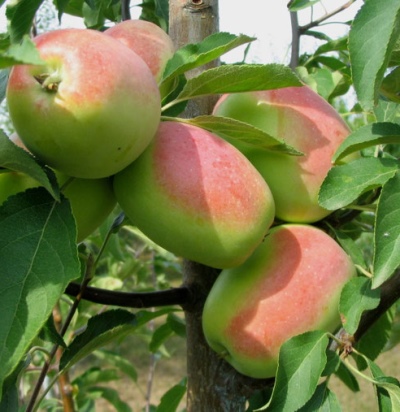
- Authors: Ukraine
- Taste: sweet
- Scent: pronounced
- Fruit weight, g: 120-140
- Fruit size: large or medium
- Yield: high
- The beginning of fruiting varieties: on low-growing stocks for 1-2 years, on medium-sized ones - 2-3 years, on seedlings for 6-7 years
- Ripening terms: autumn
- Removable maturity: late August-early September
- Keeping quality: until April
Kandil Sinap is a unique Crimean variety dating back more than one hundred years. Cultivated at a time when crops were considered poods, not kilograms. Almost unknown to modern fruit growers living outside the Crimea. Differs in high yield and good transportability, but at the same time requires careful attitude to the removed fruits. Dessert taste, it is considered intended for fresh consumption, however, it is good in freezing and in preparations.
Breeding history of the variety
The apple tree is considered the result of Ukrainian selection, especially since it grows only there and in adjacent territories with a similar climate.
Description of the variety
A vigorous tree with slow growth and narrow pyramidal crown. It is distinguished by the growth of fruits on fruit twigs, which grow in large numbers, as well as on spears and complex ringlets. By this, the variety obliges the fruit grower to take care of the support of thin straight shoots and branches extending from the trunk at an acute angle. Poorly pubescent shoots are characterized by sparse and small lenticels and an average length of internodes. Colored brown with a reddish tint. Lanceolate apple leaves have a pronounced oval shape, gray-green color. The tip of the leaf is pointed, sometimes elongated. The leaf blade is folded in the form of a boat with serrated edges, rests on short, slightly colored petioles.
Features, pros and cons
Considering that the variety can be safely attributed to unique, it has a lot of features, as well as advantages. For example - Kandil Sinap grows on rootstocks, and, depending on the strength of the growth of the latter, changes some characteristics.
Other differences:
unusual shape of the fruit - elongated cylindrical;
wax bloom (pruin) on fruits, which gives them visual and tactile fatness;
the pulp of the fruit is juicy, but loose, if not properly stored, it can turn into a "potato";
a big plus is the ability of fruits to be stored without a refrigerator until mid-spring, special vegetable stores can keep Qandil Sinap in perfect condition until the next harvest;
high marketability, late and long flowering, which protects the ovaries from recurrent frosts and increases the percentage of pollination.
The disadvantages include long periods before the start of fruiting - up to 15 years. That is why experts advise to grow Kandil Sinap on rootstocks of various types, then the beginning of fruiting occurs much earlier: (on low-growing stocks for 1-2 years, on medium-sized ones - 2-3 years, on seedlings for 6-7 years, on dwarf ones - 3 years ). The tendency to shedding, breaking off thin branches with large yields, too, cannot be considered a good quality, as well as the frequency of fruiting. In addition, transportation is possible only with the use of special methods of preserving fruits - protective wrapping or the use of nets, sandwiching with paper or shavings.
Ripening and fruiting
Ripening in autumn, the onset of removable maturity - the last decade of August, the first decade of September. An adult tree gives 200-300 kg.
Growing regions
The variety is grown exclusively in Crimea, it can grow in neighboring territories, but similar climatic conditions are required for good fruiting.
Yield
In nurseries where ideal conditions are created, Kandil Sinap gives 10-15 c / ha. A low-growing stock M9 is used.
Fruits and their taste
Large or medium-sized, elongated-cylindrical, greenish-yellow fruits are covered with a thin, glossy, seemingly oily skin and a beautiful blush with blurred borders. Weight 120-140 g. Juicy and tender friable pulp has a sweet dessert taste and a pronounced apple aroma. Excellent keeping properties guarantee the safety of the crop until mid-spring.

Growing features
The main feature is the cultivation of Qandil Sinap on a rootstock. The variety requires fertile soil rich in humus. The acidity level depends on the rootstock - from 5.5 to 6.5 pH. Landing sites are chosen with good lighting and protection from strong and cold winds. Weak rootstocks will require the installation of a support, to which the bent competitive shoots can subsequently be tied, thus avoiding future breaks.
The distance between holes and rows is maintained within 3-4 meters. The dimensions of the pits are 80x80 cm. Drainage is laid at the bottom of the pit (gravel, pebbles, broken brick, pieces of thick twigs). The excavated soil is enriched with organic matter (humus, compost, bird droppings), and minerals such as superphosphate. If necessary, a support is installed in the hole in advance, to which the stem of the stock is tied. After planting, the ground is tamped, carefully making sure that the root collar is above the ground. The trunk circle is carefully spilled, repeating this procedure for the first few weeks if the weather is dry. Further care consists in watering, preventive treatments, crown formation, sanitary pruning.






The apple tree is a popular fruit crop among gardeners. It can be found in many summer cottages. But at the same time, such trees are often affected by various diseases. It is very important to recognize the disease in time and carry out the necessary procedures for a speedy recovery. Otherwise, the fruits will be spoiled, and the tree itself may die altogether.












































































